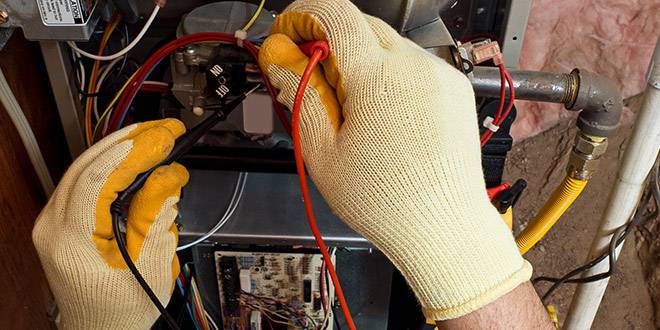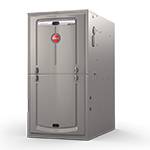
As temperatures drop, the efficiency and reliability of a gas furnace transition from a mere convenience to an absolute necessity. The warmth of your home or the comfort within your business premises hinges significantly on this crucial equipment. Understanding the common issues that can arise with gas furnaces is not just about ensuring comfort; it’s about promoting safety, efficiency, and reliability. This guide aims to equip you with the knowledge to diagnose, fix, and, most importantly, prevent the frustrations that often accompany gas furnace problems.
Understanding Gas Furnace Basics

Before delving into common problems and troubleshooting strategies, it’s crucial to grasp how a gas furnace operates and why routine maintenance is paramount. This foundational knowledge not only aids in recognizing early signs of trouble but also underscores the importance of professional upkeep in ensuring the longevity and efficiency of your heating system.
How a Gas Furnace Works
A gas furnace is a key component of your home’s heating system, converting natural gas into heat to maintain a comfortable indoor environment. The process begins when the thermostat signals the furnace to start. Natural gas is then ignited in the burner within the combustion chamber, producing heat. This heat is transferred to the warm air circulating through the heat exchanger, warming it before it is distributed throughout your space via the ductwork.
The Importance of Regular Maintenance
Regular maintenance is the linchpin of a furnace’s efficiency and safety. It involves checking the combustion process for efficiency and safety, inspecting for a cracked heat exchanger, replacing the air filter to ensure proper airflow, and verifying that the thermostat is functioning correctly. These steps help prevent common issues such as uneven heating, high energy bills, and potential safety hazards like carbon monoxide leaks.
Routine checks also extend the lifespan of your furnace by ensuring that all components are in optimal condition, thus preventing the undue strain that can lead to premature wear and tear. Professional maintenance services can identify and rectify minor issues before they escalate into major problems, saving you time, money, and discomfort in the long run.
When to Schedule Professional Maintenance
The best practice is to schedule a professional maintenance visit at least once a year, ideally before the heating season begins. This proactive approach ensures that your furnace is in peak condition to provide reliable and efficient heating throughout the colder months. It’s also an opportunity to catch and address any potential issues that could disrupt your comfort or safety during the winter.
The 5 Most Common Gas Furnace Problems
A well-maintained gas furnace is a cornerstone of comfort during the colder months. However, even the most reliable systems can encounter issues. Understanding these common problems is the first step toward ensuring your furnace operates efficiently and safely. Here, we delve into some of the most frequent challenges homeowners and businesses face with their gas furnaces, along with insights into identifying and addressing these issues.
1. Lack of Maintenance
One of the primary causes of gas furnace problems is neglecting regular maintenance. Over time, dust and debris can accumulate in the furnace, leading to reduced efficiency, potential safety hazards, and even system failure. Regular maintenance checks can prevent these issues by ensuring that your HVAC system is clean, properly adjusted, and in good working order.
2. Pilot Light or Ignition Control Issues
A malfunctioning pilot light or ignition system is a common issue that can prevent your furnace from producing heat. Modern furnaces use electronic ignition systems, which are more reliable than the old-standing pilot lights but can still encounter problems. If your furnace fails to ignite, it could be due to a faulty ignition control, a problem with the gas supply, or a lack of electrical power to the ignition system.
3. Thermostat Malfunctions
The thermostat is the command center of your heating system. When it’s not working correctly, it can lead to a host of problems, including no heat, intermittent heat, or even constant running of the furnace. Sometimes, the issue is as simple as needing new batteries or recalibration, while other times, it may indicate a need for a new thermostat.
4. Air Flow Problems
Restricted airflow can significantly impact your furnace’s efficiency and your home’s comfort. Common culprits include clogged air filters, blocked vents, or issues with the blower motor. Regularly replacing or cleaning air filters and ensuring vents are unobstructed can help maintain proper airflow.
5. Unusual Noises
Strange sounds coming from your furnace can be alarming and may indicate various problems. Rattling noises might suggest loose panels that need tightening while whistling or humming could point to airflow restrictions or electrical issues. A professional inspection can help determine the cause of these noises and the appropriate fixes.
DIY Troubleshooting Tips

Encountering a problem with your gas furnace can be daunting, but there are several troubleshooting steps you can safely perform at home before calling in the professionals. These tips can help you diagnose and possibly resolve minor issues, restoring warmth and comfort to your space efficiently. However, remember that gas furnaces involve complex systems and potentially dangerous components like natural gas and electricity. Exercise caution, and when in doubt, always consult a professional.
1. Check the Thermostat
A common issue that may seem like a furnace problem is actually a thermostat setting error. Ensure your thermostat is set to “heat” mode and that the temperature setting is higher than the current room temperature. If your thermostat is programmable, check that it’s not set to a schedule that reduces the temperature at certain times of the day.
2. Inspect the Air Filter
A clogged air filter can restrict airflow, significantly reducing your furnace’s efficiency and potentially causing it to overheat and shut down. Check your air filter every month during the heating season and replace it if it’s dirty. This is one of the simplest yet most effective ways to maintain your furnace’s performance.
3. Ensure Vents Are Open and Unobstructed
Blocked or closed vents can cause uneven heating and put unnecessary strain on your furnace. Walk through your home to ensure all vents are open and free of obstructions like furniture, curtains, or rugs. This allows for proper airflow throughout your space, promoting efficient heating and system operation.
4. Check the Furnace Switch and Electrical Panel
Your furnace has a safety switch that looks like a regular light switch, usually located on or near the furnace. Ensure this switch is in the “on” position. Additionally, check your home’s electrical panel for any tripped breakers or blown fuses that could be affecting your furnace’s power supply.
5. Examine the Gas Supply
If your furnace isn’t heating at all, there might be an issue with the gas supply. Ensure the gas valve to your furnace is fully open. If you suspect a gas leak or smell gas, leave the area immediately and contact your gas utility company or a professional from a safe distance. Do not attempt to fix gas leaks yourself.
Professional Solutions for Gas Furnace Problems
When DIY troubleshooting doesn’t resolve your furnace issues or when you encounter problems that require technical expertise, professional intervention becomes necessary. Complex issues such as malfunctioning ignition systems, persistent unusual noises, and efficiency problems often require the knowledge and tools that only professionals possess. Here, we outline the types of professional solutions available for common gas furnace problems, emphasizing the importance of expert care in maintaining the health and longevity of your heating system.
1. Comprehensive Diagnostic Services
Professional HVAC technicians use advanced diagnostic tools to identify the root cause of your furnace’s problems precisely. This thorough evaluation goes beyond surface-level symptoms to ensure accurate, effective repairs. Whether it’s a malfunctioning component, a safety issue, or an efficiency problem, a comprehensive diagnostic approach ensures nothing is overlooked.
2. Ignition System Repairs
Problems with the furnace’s ignition system can prevent your heating system from starting or operating reliably. Technicians can repair or replace faulty ignition components, including pilot lights, electronic ignition modules, and thermocouples, to restore proper function to your furnace.
3. Thermostat Replacement or Repairs
Sometimes, the issue lies not with the furnace itself but with the thermostat controlling it. Professionals can determine whether your thermostat needs recalibration, repair, or replacement. Upgrading to a smart thermostat can also offer improved efficiency and control over your heating system.
4. Airflow and Ductwork Adjustments
Restricted airflow can lead to inefficiency and uneven heating. A professional can clean and adjust the blower motor, inspect and repair ductwork, and ensure that your furnace’s ventilation system is functioning optimally. This not only improves your comfort but can also extend the life of your furnace by preventing overheating and excessive wear.
5. Regular Maintenance and Tune-ups
One of the most effective professional solutions is preventative maintenance. This includes cleaning the furnace, checking for leaks, inspecting the heat exchanger, testing safety controls, and ensuring the system is operating at peak efficiency. Regular maintenance can prevent unexpected breakdowns, improve safety, and reduce energy costs.
6. System Upgrades and Replacements
In some cases, the best solution for recurring or severe furnace problems is to upgrade to a newer, more efficient model. Professionals can advise on the best options for your needs and budget, handle the installation process, and ensure your new system is optimized for performance and efficiency.
Turning to professionals for furnace problems not only ensures safe and effective repairs but also provides peace of mind, knowing that your heating system is in good hands. With their expertise, you can avoid the frustration of recurring issues, improve your system’s efficiency, and enjoy a warmer, more comfortable space.
Preventive Measures to Avoid Future Gas Furnace Problems

Preventive maintenance is key to ensuring the longevity, efficiency, and reliability of your gas furnace. By taking proactive steps, you can avoid many common problems that lead to discomfort, high energy bills, and costly repairs. Here are several preventive measures you can implement to keep your furnace running smoothly and efficiently for years to come.
1. Schedule Regular Professional Maintenance
The cornerstone of preventing furnace problems is to schedule annual maintenance checks with a professional HVAC service. These checks include a thorough inspection, cleaning, and adjustment of your furnace components to ensure everything is in optimal condition. Regular maintenance can catch potential issues before they become major problems, ensuring your furnace operates efficiently and safely.
2. Change Air Filters Regularly
One of the simplest yet most effective preventive measures is to change your furnace’s air filter regularly. A clean air filter ensures proper airflow, improves indoor air quality, and helps your furnace run more efficiently. Depending on your filter type and household conditions, you should change the filter every 1 to 3 months during the heating season.
3. Ensure Proper Thermostat Use
A properly functioning thermostat is essential for efficient furnace operation. Make sure your thermostat is correctly set for the season and that it’s not influenced by direct sunlight, drafts, or other heat sources that could affect its readings. Consider upgrading to a programmable or smart thermostat to better control your heating settings and save on energy costs.
4. Keep Vents and Registers Clear
Ensure that all vents and registers in your home are open and unobstructed by furniture, curtains, or rugs. This allows for proper air circulation, preventing your furnace from overworking and ensuring even heating throughout your space.
5. Listen for Unusual Noises
Be attentive to your furnace’s operation and listen for any unusual noises. Sounds like banging, whistling, or humming can indicate problems that, if addressed early, can prevent more significant issues. Contact a professional if you notice any persistent or concerning sounds.
6. Inspect Your Chimney and Ventilation System
Ensure that your chimney and ventilation system are inspected annually for blockages, leaks, or damage. Proper venting is crucial for removing harmful combustion byproducts and maintaining the efficiency and safety of your furnace.
7. Consider System Upgrades
If your furnace is old or frequently requires repairs, it may be more cost-effective in the long run to upgrade to a newer, more energy-efficient model. Newer furnaces offer improved comfort, better efficiency, and often come with features that enhance reliability and reduce environmental impact.
By implementing these preventive measures, you can significantly reduce the likelihood of furnace problems, ensuring your system remains a reliable source of warmth and comfort. Regular care not only extends the life of your furnace but also contributes to a safer, more energy-efficient home or business environment.
Secure Your Comfort with BV Air Conditioning & Heating
Embrace peace of mind and optimal warmth by scheduling your furnace maintenance with BV Air Conditioning & Heating today. Ensure your system’s longevity, efficiency, and safety with our expert care. Join our satisfied customers and experience the difference professional service makes. Act now for a comfortable tomorrow! Call or click here to book your appointment.



